SanDisk Extreme PRO USB 3.0 Flash Drive Capsule Review
by Ganesh T S on November 27, 2014 7:00 PM EST- Posted in
- Storage
- USB 3.0
- Flash Drive
- SanDisk
Storage Benchmarks
Synthetic Benchmarks - ATTO and Crystal DiskMark
SanDisk claims read/write speeds of 245 MBps/190 MBps and 260 MBps/240 MBps respectively for the Extreme and Extreme PRO. These are backed up by the ATTO benchmarks provided below. Unfortunately, these access traces are not very common in real-life scenarios.
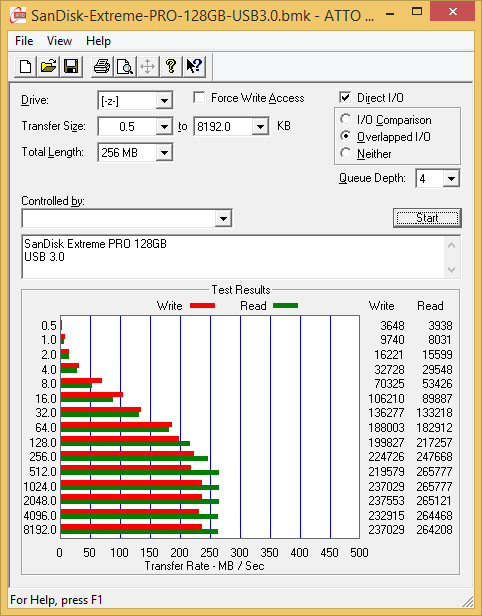
CrystalDiskMark, despite being a canned benchmark, provides a better estimate of the performance range with a selected set of numbers. As evident from the screenshot below, the performance can dip to as low as 8.7 MBps for 4K read accesses at QD32. However, these types of accesses are not common for the large size file transfers that form the primary use-case for the Extreme and Extreme PRO.
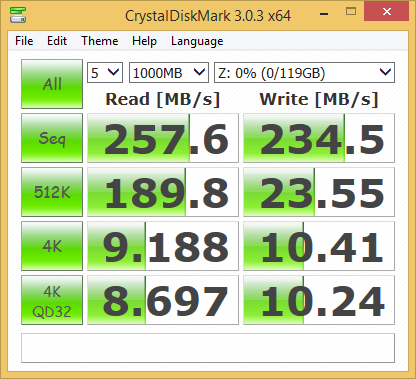
Real-Life Benchmarks - robocopy and PCMark 8 Storage Bench
Our testing methodology for DAS units also takes into consideration the usual use-case for such devices. The most common usage scenario is transfer of large amounts of photos and videos to and from the unit. The minor usage scenario is importing files directly off the DAS into a multimedia editing program such as Adobe Photoshop.
In order to tackle the first use-case, we created three test folders with the following characteristics:
- Photos: 15.6 GB collection of 4320 photos (RAW as well as JPEGs) in 61 sub-folders
- Videos: 16.1 GB collection of 244 videos (MP4 as well as MOVs) in 6 sub-folders
- BR: 10.7 GB Blu-ray folder structure of the IDT Benchmark Blu-ray (the same that we use in our robocopy tests for NAS systems)





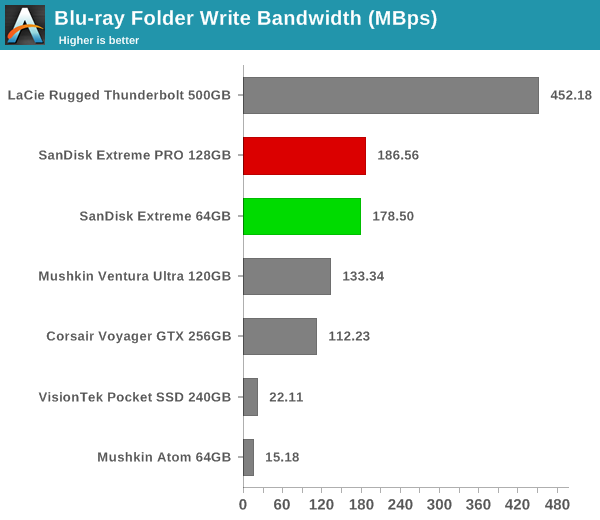
The general trend we observed was that the SanDisk Extreme was better at read benchmarks (though the Extreme PRO was quite close). When it came to the writes, the Extreme PRO pulled ahead (sometimes by as much as 25 MBps for lots of small files).
For the second use-case, we take advantage of PC Mark 8's storage bench. The storage workload involves games as well as multimedia editing applications. The command line version allows us to cherry-pick storage traces to run on a target drive. We chose the following traces.
- Adobe Photoshop (Light)
- Adobe Photoshop (Heavy)
- Adobe After Effects
- Adobe Illustrator
Usually, PC Mark 8 reports time to complete the trace, but the detailed log report has the read and write bandwidth figures which we present in our performance graphs. Note that the bandwidth number reported in the results don't involve idle time compression. Results might appear low, but that is part of the workload characteristic. Note that the same testbed is being used for all DAS units. Therefore, comparing the numbers for each trace should be possible across different DAS units.




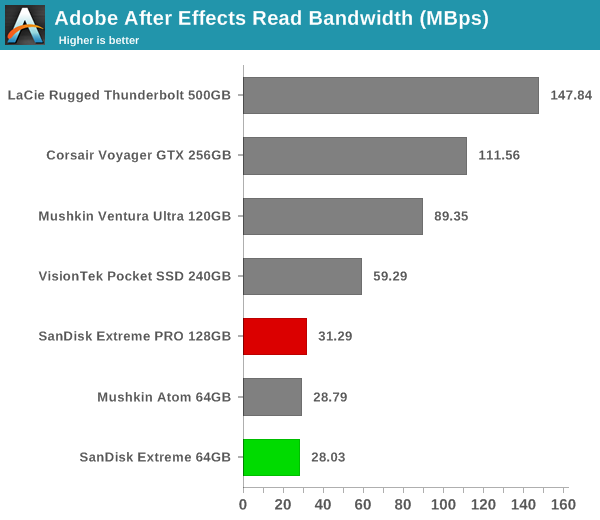
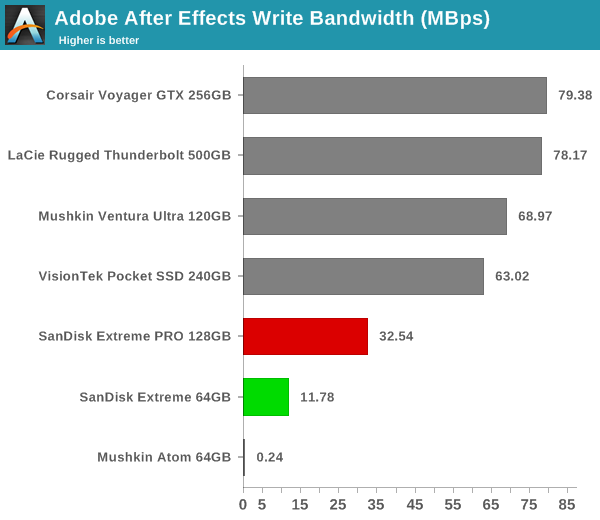
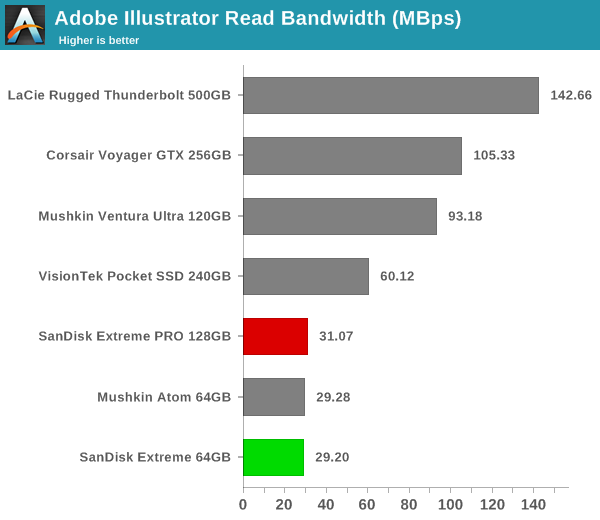

The workload traces from PCMark 8's storage bench are meant to evaluate SSDs (which is the reason the drives based on SSD controllers give great results). The firmwares in the SanDisk units being evaluated today are not optimized for these types of accesses. We wouldn't read much into the standings of the SanDisk units in the above graphs, except for the fact that one shouldn't try editing multimedia files directly off them.










31 Comments
View All Comments
Bullwinkle J Moose - Saturday, November 29, 2014 - link
The Sandisk Extreme 64GB is PERFECTLY FINE for use as a Windows to Go DriveEven with Bitlocker Software Encryption Enabled, the Sandisk Extreme is more usable when playing Counterstrike on Steam than a Patriot Supersonic Boost 32GB running Linux Mint WITHOUT ENCRYPTION
Actual Write Speeds tested on Sandisk with Bitlocker Enabled
A single 5,693,912 KB Drive Backup copied to Encrypted Sandisk @ 7.23MB/sec (787 seconds)
152 MP3's @ 607 MB copied to Sandisk @ 7.49 MB/sec (81 seconds)
-----------------------------------------------------------------
Actual Read Speeds from Encrypted Sandisk
A single file 5,693,912 KB copied to Samsung 840 Pro @ 154 MB/sec
152 MP3's / 607 MB copied to Samsung 840 Pro @ 107 MB/sec
The real problem is that you will have no idea whether you are getting the Fixed Disk version or the Removable Disk version of the Sandisk Extreme when you order from Amazon
Both versions come in EXACTLY the same packaging but only the Fixed Disk works with Windows to Go
Sandisk switched back to "removable disk" without providing any usable way to identify which is which but they will offer to swap disks with you if you received the wrong one and you complain enough
digiguy - Sunday, November 30, 2014 - link
It would be interestinsting to know how these flash drives (I have the Sandisk extreme and the Corsair GTX 256) compare to the Diskgo Sonic (e.g. 240GB version http://us.edgememory.com/index.php/usb-flash-drive... ), which claims speeds that seem the best in the market, but looks like the throttled Ventura Ultra and Visiontek... Or to the slower but Windows to go certified Ironkey W700 (very expensive).Bullwinkle J Moose - Sunday, November 30, 2014 - link
Buying a rebranded Mushkin drives should give you the same results or worse than a MushkinCheck the warranty for a clue to them buying parts that diddnt meet the specs from mushkin or just read the mushkin reviews at newegg like this one>
Claiming "Read: up to 445MB/s Write: up to 440MB/s" on a device that starts at around 120 MB/s (acceptable) but then will drop to 20MB/s when it warms up is unacceptable.
Telling me that it was designed to do that is insulting.
It will be snowing in hell before I buy a Mushkin product again.
An utterly disappointing experience. Stay away from this thing.
-------------------------------------------------------------------------------------------
Sandisk 64GB turned out to be the best buy/GB/quality/consistency of them all in my opinion
Bullwinkle J Moose - Sunday, November 30, 2014 - link
forget edge memoryjust "TRY" to find the warranty info from the warranty link at Tiger Direct
If you enjoy hurting yourself, The mushkin branded version at newegg is $45 cheaper anyway
Bullwinkle J Moose - Sunday, November 30, 2014 - link
Forget Mushkin as wellNewegg has changed the content of complaints that were on the site just a few months ago for damage control
Customers were complaining that their Mushkin drives were incredibly slow, registering 120MB/sec and lower when they received this response>
----------------------------------------------------------------------------
Manufacturer Response:
Hello, Unhappy!
Is this USB being plugged into an USB 3.0 port? From our experience, these USB Drives will not function at listed speeds in an USB 2.0 port.
If you continue to have issues, please contact us at Support@Mushkin.com so we can address your concerns.
Thank you, and be well!
------------------------------------------------------------------------
Any Manufacturer that questions if you are using USB 2.0 to get the slow speeds of 120 MB/sec is not to be trusted with my money as USB 2.0 tops out around 45MB/sec
digiguy - Sunday, November 30, 2014 - link
So you are basically saying that Mushkin, Visiontek and Edge are basically the same product, like sold as different brands or very similar products made buy one manufacturer and sold by different companies. It could well be possible, especially as Anandtech has found that Mushkin and Visontek are comparable in terms of throttling. I was however not going to buy. I am already more than happy with my Sandisk Extreme and Corsair Voyager GTX 256 (the fastest flash drive on the market...)Chromatin1 - Tuesday, December 2, 2014 - link
I'm not sure where you found the Sandisk 64 GB extreme for $28, as even the page link of the article come in at $68. The cheapest price I can see after a brief look on the internet is around $48. Maybe this was a black friday sale? A little pricey for me as a stocking stuffer.RyuDeshi - Tuesday, December 2, 2014 - link
Yes, a couple stores had it for $28 for a few days before black Friday. Not sure why they are talking about it like that is the normal everyday price.McMillan24 - Friday, December 5, 2014 - link
Anyway, I once used a SanDisk flash drive from which i lost all data out of the blue. However, I was lucky to recover back each and every file with the help of a recovery software that i found in this tutorial video - http://youtu.be/FYFyWUWn5CgGadgetsRGrt4All - Saturday, December 6, 2014 - link
I bought the Sandisk Extreme Pro 128 a couple months back for around $100. No complaints about the cost for the storage size, and I like the metal casing and retractability. Performance is top-notch, and my disk speed testing agrees with the manufacturer's top speed estimates. Love how fast it copies huge files, which was my main reason for the purchase. I primarily work on OSX10.10 platforms, with W7, W8, and CentOS Linux virtual machines. So I would want to see Anandtech demonstrate the effects of different operating systems, i.e. W7, W8, OSX10.9, OSX10.10, Linux, and their respective best disk formats, on the performance metrics. Until that is broken out, I'm not sure how much value to derive from what was presented here.